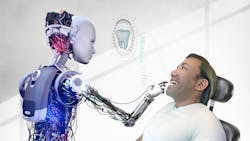Dentistry leads the AI revolution (despite its late arrival)
If you look back at the short history of artificial intelligence (AI) in health care, you’ll see that it has blazed its brightest trail in fields where it supports life-saving treatment: oncology, cardiology, pulmonology, and the foundation of it all—radiology.
The clinical adoption of AI by radiologists has been swift compared to dentistry. According to the American College of Radiology, about 30% of radiologists now work with AI, and its use in the field is advancing. Mass General Brigham hospital has developed algorithms that can detect abdominal aortic aneurysms.1 Harvard researchers have developed AI that detects disease on chest x-rays using natural language descriptions in clinical reports2 and can do it as accurately as human experts.3
“Over the next 10–15 years, we’ll see more models become widely available and adopted, with the average radiologists practicing with 20-40 algorithms each, depending on their subspecialties,” predicts Keith Dreyer, DO, PhD, the chief data science officer and vice chairman of radiology at the Mass General Brigham health system.
Of course, by then, dentistry will have done the work of bringing AI diagnostics into the mainstream. Dentists may be behind the curve on adoption, but they’re swiftly catching up and bringing it to the front line of patient care. In time, it’s dentistry that will make AI ubiquitous in health care. Here’s why.
AI encounters of the everyday kind
AI that detects a malignant brain tumor makes headlines. AI that detects caries on tooth 17, not so much. But according to the CDC, 90% of Americans ages 20 and up have had at least one cavity in their lifetime.4 (25% have one right now.4) Thankfully, fewer than 1% will develop a brain tumor.5
What that boils down to is that very few people will encounter AI within the confines of traditional medicine. Medical doctors don’t refer their patients for x-rays or scans until there is cause for concern. AI is called in to support life-or-death diagnoses.
AI in dentistry: 7 building blocks to protect your practice
Success in orthodontics with AI
Dental offices, on the other hand, perform x-rays every day, and patients get x-rays taken at annual checkups. In other words, well care in dentistry starts with imagery. Since 65% of American adults (about 136 million people) visit the dentist every year,6 according to the CDC, they have a much higher chance of encountering AI-based diagnostic software while seated in the dentist’s chair.
AI-backed software available to dentists can help them identify and diagnose pathologies that appear on x-rays. But they are also powerful tools for building patient trust. While patients get dental x-rays taken every year, they aren’t experts at reading them. According to a recent survey of dental patients, 65% said they don’t completely understand what their dentist is pointing out to them on those x-rays.7 AI bounding boxes provide a focal point for patients struggling to see what their dentist is pointing to.
This may be one reason why dentists are adopting the technology so quickly. While we’ve seen exponential growth at Pearl, there’s outside evidence that AI is making fast inroads. A 2022 study of how often AI appears in dental literature showed a 21.6% increase between 2011 and 2021 and an even starker uptick of 34.5% over the last five years.8 And of the publications selected from 2021, 26.36% of those references were to radiology, the day-to-day exposure most likely to popularize AI among patients.8
Entrepreneurial adoption
Of course, AI can do much more for dentists and dental offices than just help read x-rays. It can help with treatment planning, margin calculations, and back-office operations. Unlike doctors who work in hospital systems, 73% of dentists own their practices, according to the American Dental Association.9 The significance of that is twofold.
First, dentists have a financial interest in maximizing treatment and production. Empty schedules mean patients aren’t getting the treatment they need—and that practices aren’t using their hours efficiently. When AI gives the front office an edge in identifying urgent and high-need cases that fill out the weekly schedule, practice owners are likely to consider it.
Secondly, purchasing AI tools within medical systems is subject to lengthy panel reviews, RFP (requests for proposal) processes, and vendor evaluations. The slow march of bureaucracy impedes the adoption of everyday tools by physicians. Meanwhile, dental practice owners need only consult themselves or their partners when deciding if they should try AI-powered software.
More and more, dentists are choosing to do so. That choice will make dentistry the field in which AI is most ubiquitous.
Editor's note: This article appeared in the February 2023 print edition of Dental Economics magazine. Dentists in North America are eligible for a complimentary print subscription. Sign up here.
References
- Siwicki B. Mass General Brigham and the future of AI in radiology. Healthcare IT News. May 10, 2021. Accessed November 7, 2022. https://www.healthcareitnews.com/news/mass-general-brigham-and-future-ai-radiology
- Pesheva E. No labels? No problem! New tool overcomes major hurdle in clinical AI design. Harvard Medical School. September 15, 2022. Accessed November 7, 2022. https://hms.harvard.edu/news/no-labels-no-problem
- Tiu E, Talius E, Patel P, Langlotz CP, Ng AY, Rajpurkar P. Expert-level detection of pathologies from unannotated chest X-ray images via self-supervised learning. Nat Biomed Eng. September 15, 2022. doi:10.1038/s41551-022-00936-9
- Oral health surveillance report: trends in dental caries and sealants, tooth retention, and edentulism, United States, 1999–2004 to 2011–2016. Division of Oral Health, National Center for Chronic Disease Prevention and Health Promotion. Centers for Disease Control and Prevention. 2019. Updated December 9, 2021. https://www.cdc.gov/oralhealth/publications/OHSR-2019-index.html
- Key statistics for brain and spinal cord tumors. American Cancer Society. Updated January 12, 2022. Accessed November 7, 2022. https://www.cancer.org/cancer/brain-spinal-cord-tumors-adults/about/key-statistics.html
- National health interview survey. National Center for Health Statistics. Centers for Disease Control and Prevention. 2019. Updated November 21, 2022. https://www.cdc.gov/nchs/nhis/index.htm
- Dental patient trust & technology survey: technology’s role in building trust among dental patients. Pearl. 2022. Accessed November 7, 2022. https://www.hellopearl.com/guides/patient-trust
- Thurzo A, Urbanová W, Novák B, et al. Where is the artificial intelligence applied in dentistry? Systematic review and literature analysis. Healthcare (Basel). 2022;10(7):1269. doi:10.3390/healthcare10071269
- Practice ownership among dentists continues to decline [infographic]. American Dental Association Health Policy Institute. 2021. https://www.ada.org/-/media/project/ada-organization/ada/ada-org/files/resources/research/hpi/hpigraphic_practice_ownership_among_dentists_decline.pdf
About the Author
Kyle Stanley, DDS
Kyle Stanley, DDS, is an award-winning dentist and the chief clinical officer at Pearl, an AI company specializing in diagnostic and business analytics solutions for the dental industry. A graduate and former faculty member of the University of Southern California’s Herman Ostrow School of Dentistry, Dr. Stanley is a key opinion leader and public speaker whose esthetics, dental implant, and smile design research has been published in the top international dental journals. He maintains a private practice in Beverly Hills, California.
Updated December 7, 2022

